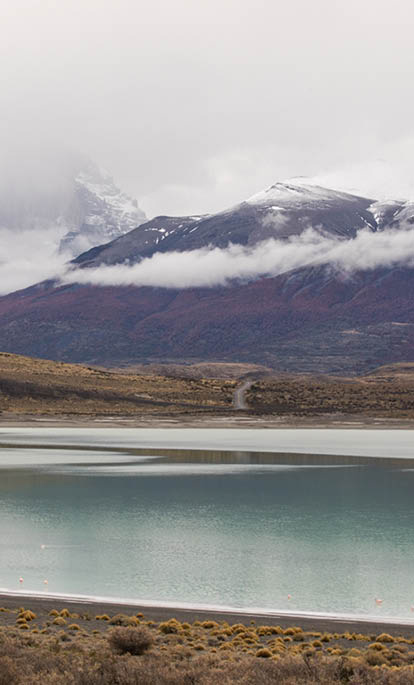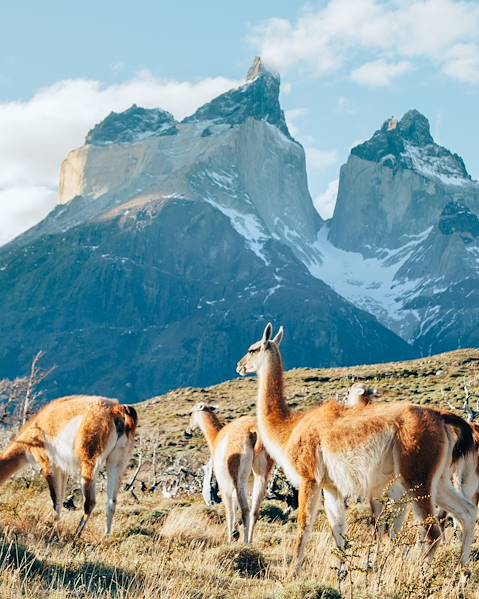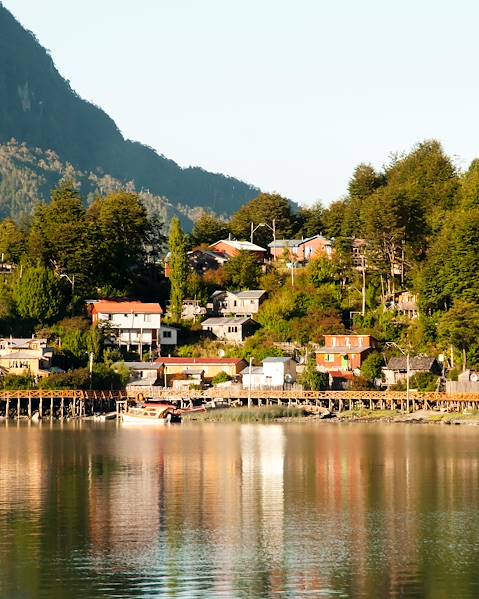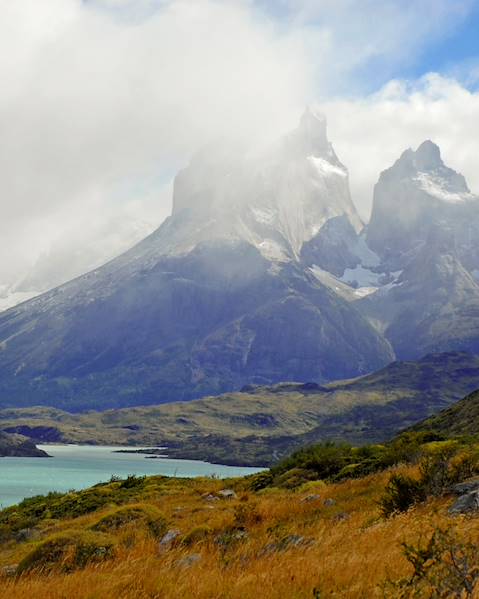Stretching almost the entire length of South America’s western coast, Chile is home to spectacular scenery, beautifully wild landscapes and a wide range of activities for all who visit. Explore the surroundings of Patagonia with a Jeep or helicopter tour, discover Latin America’s finest ski resort of Portillo and much more. Read on for our top recommendations for things to do in Chile.
Ski Portillo
Just two hour's drive from the capital Santiago, Portillo is the finest ski resort in Latin America, with a majestic Andean setting and unique for its small size. This has been South America’s premier destination ski resort for more than 50 years.
The skiing is predictably excellent, with lengthy runs to suit all abilities and some of the finest powder conditions around. Thanks to a strict policy of only allowing 450 people on to the slopes on any one day, there are never queues at the lifts. The lift system itself consists of 14 lifts (including five chairlifts), and for the more adventurous skier, the unique Va et Vient lifts allow access to the high avalanche couloirs across the Roca Jack and the Condor slopes with their open-slope powder skiing.
Add in world class service and facilities and this is a resort experience that leaves many in Europe found wanting.
Patagonia Jeep Expedition
Take an overland expedition by Jeep and travel wild Patagonia in style with luxury and comfort. Explore the large and diverse region and experience the joy of seeing nature in its purest form.
Located at the southernmost point of South America, Patagonia is a territory shared by the countries of Chile and Argentina and home to some of the most incredible landscapes on earth.
Gaze at the jaw-dropping scenery with its intense natural shades and organic shapes. Pass the amazing Patagonian sites, such as Torres del Paine National Park, Los Glaciares National Park and the breath taking Perito Moreno Glacier. Drive the dirt road along the southern shore of Lago Viedma, Argentina's second largest lake, and stop for amazing open sky views of the lake and the surrounding mountains.
Drive across tiny bridges, creeks and see sculptures of floating and melting icebergs calved from Viedma Glaciers further up the fjord. You can be driven or self-drive for weeklong expeditions, following breifings with professional guides. The jeeps are fully equipped with GPS ranger, which is automatically activated in certain places to tell you about points of interest. There is a Garmin navigation system, which is preloaded with all the places you need to go to, so you don't make any wrong turns... Fear not as the jeeps have all the bits and bobs you need should you break down. More importantly there is a cool box filled with snacks and drinks.
Helicopter Ride in Patagonia
The dramatic landscapes of Chilean Patagonia are not to be missed. Head to Northern Patagonia and stay at the only local hotel with its own helicopter on site, giving you the chance to soar above the active Villarica Volcano and look into its bubbling crater. While up in the air you can also enjoy fantastic views of the surrounding lakes, forests and other snow-capped volcanoes.
Explore the Atacama Desert
The Atacama Desert is usually high on most people's wish lists for a visit to Chile because of its incredible and unique landscapes. Be sure to give yourself enough time here so you can tackle the excursions at higher altitude once you have acclimatised a little, such as a sunrise visit to the Tatio Geysers, which are found over 14,000 feet above sea level.
Harvest Experience at a Vineyard
Take part in the harvest experience at one of Chile's leading biodynamic and organic wineries. After a gourmet dinner, join the team from the vineyard and harvest grapes using a headlight, scissors and gloves, then take your box back to the winery and watch your grapes enter the wine making process. You can then taste the newly pressed grape juice as well as some local wine during its fermentation process.
Things to do in the Atacama Desert
Stargazing
The vast expanse of the Atacama Desert, the driest non-polar place on the planet, is perfect for stargazing with its tens of thousands of miles of uninterrupted skies. If staying at Alto Atacama you can do this in the relaxed setting of their very own private observatory with an expert star guide, who can teach you all about astronomy as you gaze up at the dazzling night sky.
Sundowners in the Valley of the Moon
A short drive from the town of San Pedro de Atacama, the unique landscape of the Valley of the Moon is a photographer's dream. Get snap happy while the sky changes to the same fiery red tones as the rocks and sand of the valley. Alternatively, cycle from San Pedro through the desert which resembles what one would assume the surface of Mars looks like.
Visit Los Flamencos National Reserve
From San Pedro de Atacama, head into Los Flamencos National Reserve to see the flocks of flamingos that live here and mill around in the intense blue saline lakes and lagoons. The stark pink of these majestic birds stands out in the lunar-like landscape and is an iconic sight of the Atacama.
Things to do in Santiago & Central Valley
Visit Valparaiso
Take a day trip to Valparaiso, a jewel of a city by the sea. Explore its maze of alleyways, spiralling staircases and multi-coloured buildings. It's a mecca for artists where you can peruse walls covered in vibrant graffiti. Next, travel up the slopes on a canary-yellow funicular that connect the hilltops with the sprawling city below where you can lap up fantastic panoramas.
A Historic Tour of Santiago
Stop at the main Plaza de Armas, the historic heart of the city. Here you can admire its colonial architecture and fountain honouring the famed libertador, Simon Bolivar. Pause underneath the palms as you learn the city's history before a ten-minute walk to the glorious La Moneda Presidential Palace, the seat of the country's president. Don't miss the changing of the guards complete with brass bands and plenty of pomp.
Panoramas on Cerro San Cristobal
For the best views of Santiago, take the funicular up to the Cerro San Cristobal rising at around 1,000ft above the city. Alternatively, walk for an hour on a pretty, forested trail to its summit. Reach the second highest point in the city and stand by the gleaming statue of the Virgin Mary from where you can soak up sweeping urban views.
Things to do in The Lake District
Horseback Riding on Chiloe
Channel your inner huaso (Chilean cowboy) and explore Chiloe island on horseback. Venture through open prairies and charming farmland where you'll meet locals tending to their crops, encounter impressive Andean vistas and spot beautiful native flowers along the way. Your destination is Quento beach, a wild coastal spot - when the tide recedes, you can dismount and enjoy a picnic on the sand gazing out to the iridescent blue.
White-water Rafting
Take a white-water rafting adventure down the Petrophue river. Don your state-of-the-art rafting kit and, from the moment you start paddling, you'll experience a variety of scenery; emerald river water glistening in the sun, lush rainforest and conical snow-capped volcanoes. Hurtle down exhilarating grade three rapids while also taking in quieter moments of serenity.
Biking on Aucar
Explore Chiloe's sweeping coastal landscapes on a fun bike ride. First stop, a museum dedicated to celebrated Chilean author, Francisco Coloane, whose seafaring stories were inspired by island myths. Next, peddle to Aucar Island winding through a beguiling array of endemic flora. En-route, you'll pop into three UNESCO-listed churches, each one representing unique architecture, a fascinating mix of Jesuit and Chiloe style.
Things to do on Easter Island
Visit Rano Raraku
Visit the volcanic crater of Rano Raraku in the south-east of the island, which was used as the quarry where around 95% of the island's famous Moai statues were cut. The statues were carved directly into the stone and then detached and moved around the island, although around 400 remain in the crater, mostly unfinished.
Explore the Island on a Guided Hike
Spend a full day exploring the island with an expert guide and hike the ancient Moai transportation routes, taking in some of the island's most impressive Moai statues along the way. It is believed the statues were transported along ancient roads, but it is still a mystery how this was done, as there were no wheels or large animals on the island that could have helped.
Snorkel in Bird Islets
Take a boat from Hanga Roa to explore sea caves while enjoying impressive views of the cliffs, the Rano Kau crater and Motu Nui islet. Snorkel in the crystal clear water and explore one of Easter Island's biggest attractions: its underwater world. The island's remote location means the water is beautifully clear and you can see wonderful coral, marine life and even underwater Moai statues.
















